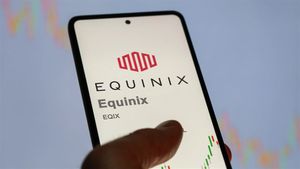
Vedanta Limited (NSE: VEDL), a global diversified natural resources company, has announced a landmark performance for the second quarter of Fiscal Year 2026 (Q2 FY26), reporting its highest-ever quarterly EBITDA of ₹11,612 crore. This impressive 12% year-on-year surge, coupled with a significant expansion in EBITDA margin to 34%, underscores the company's robust operational strength and strategic foresight. The record-breaking results, unveiled on October 31, 2025, are poised to send positive ripple effects across the metal commodity markets, particularly as Vedanta's aggressive capacity expansion initiatives come to fruition.
This exceptional financial showing by one of the world's leading diversified natural resources companies not only highlights Vedanta's internal efficiencies and strategic growth but also provides a critical barometer for the broader metal sector. With significant production milestones achieved across its aluminium, zinc, and power segments, Vedanta's trajectory suggests a period of sustained growth, potentially influencing global supply dynamics and pricing trends for key industrial metals. Investors and industry observers will be closely watching how this performance translates into sustained market shifts and competitive responses.
Record-Breaking Performance Propelled by Strategic Expansion and Operational Excellence
Vedanta Limited’s Q2 FY26 results reveal an unprecedented financial achievement, with the company hitting its highest-ever quarterly EBITDA of ₹11,612 crore, marking a substantial 12% year-on-year increase. The EBITDA margin also saw a healthy expansion of 69 basis points, reaching 34%. Furthermore, the company reported record quarterly revenue of ₹39,868 crore, up 5.9% year-on-year. While consolidated net profit saw a 59% decline to ₹1,798 crore, this was primarily due to an exceptional loss of ₹2,067 crore. Crucially, the profit before exceptional items demonstrated robust underlying business health, surging 13% year-on-year to ₹5,026 crore.
The primary drivers behind this stellar EBITDA growth are a powerful combination of enhanced operational efficiencies, strategic capacity expansions, favorable commodity prices, and beneficial forex movements. The company has demonstrated consistent operational excellence and strong cost management, with its subsidiary Hindustan Zinc (NSE: HINDZINC) achieving its lowest second-quarter cost of production in five years at $994 per tonne, a 7% year-on-year reduction. These cost optimizations have been pivotal in expanding profit margins.
A significant portion of the growth stems from Vedanta’s ambitious strategic capacity expansions and subsequent record production across its core segments. The aluminium division delivered record alumina production of 653 kilotonnes (kt), a 31% year-on-year increase, and record cast metal aluminium production of 617 kt, up 1% year-on-year. Key milestones included the first metal production from BALCO’s (NSE: BALCO) new 525 kA smelter – India’s largest – and the commencement of alumina output from Train II of the 3 MTPA expansion project at Lanjigarh. Zinc India also reported its highest-ever Q2 mined metal production at 258 kt, while Zinc International saw a substantial 38% year-on-year increase to 60 kt, driven by a 54% surge from Gamsberg. The power business recorded its highest-ever quarterly generation at 3,889 MU, an increase of 7.9% year-on-year, with merchant capacity expanding to 4.2 GW.
The immediate market reaction to Vedanta’s Q2 FY26 results, announced on October 31, 2025, saw the company’s shares experience a slight downturn, settling 2.5% lower at ₹494.30 apiece on the National Stock Exchange (NSE). This dip, however, followed a period of positive momentum where shares had gained 2.79% in the preceding five trading sessions and 8.68% over the last month. Prior to the results, prominent brokerage firms like Nuvama Institutional Equities, JP Morgan (NYSE: JPM), and Citi Research (NYSE: C) had expressed optimism for Vedanta’s FY26 performance, citing strong London Metal Exchange (LME) pricing trends, disciplined cost management, and ongoing capacity expansions as key growth catalysts. Vedanta’s leadership, including Executive Director Arun Misra and CFO Ajay Goel, expressed strong confidence in the company's trajectory, projecting an annual EBITDA exceeding $6 billion for the full fiscal year, which would be a historic record. The company also declared an interim dividend of ₹16 per share, reinforcing its commitment to shareholder returns.
Companies that Might Win or Lose from Vedanta's Ascendancy
Vedanta Limited's (NSE: VEDL) strategic capacity expansions and record Q2 FY26 production are poised to reshape the competitive landscape across its diversified portfolio, creating both winners and losers in the metal commodity markets. As India's largest primary aluminium producer, Vedanta's aggressive growth strategy, particularly in aluminium and zinc, will inevitably intensify competition and influence market dynamics.
In the aluminium sector, Vedanta's expansion, including the commissioning of BALCO's (NSE: BALCO) new 525 kA smelter and the ramping up of its Lanjigarh refinery, directly challenges domestic rivals like Hindalco Industries Ltd. (NSE: HINDALCO) and National Aluminium Company (NSE: NALCO). Vedanta's aim to consolidate its approximately 46% domestic market share and potentially expand globally means these competitors will face increased pressure on market share and pricing. Globally, major players such as China Hongqiao Group, Rio Tinto (ASX: RIO), and Alcoa (NYSE: AA) will observe Vedanta's growing footprint, which could contribute to overall supply increases and potentially temper international aluminium prices if demand doesn't keep pace. For Vedanta, higher volumes and a focus on value-added products are expected to boost profitability, while competitors might see margins squeezed, necessitating greater cost efficiency.
The zinc market is also set for shifts. Vedanta's subsidiary, Hindustan Zinc (NSE: HINDZINC), a major global zinc-lead miner, reported its best-ever Q2 mined metal production, alongside substantial growth from Zinc International's Gamsberg operations. This increased output will add to global zinc supply, which is already facing forecasts of a surplus and weak demand in key markets like China. While Vedanta benefits from a five-year low cost of production, a sustained decline in commodity prices due to oversupply could impact profitability for all producers, including global giants like Glencore (LSE: GLEN), MMG, and Boliden. Companies with higher operating costs would be particularly vulnerable to reduced margins in such an environment.
Beyond direct competitors, Vedanta's growth also creates opportunities for ancillary industries. Mining and processing equipment suppliers are set to benefit from the increased capital expenditure on expansion projects. Logistics and transportation providers will see higher demand for services to move raw materials and finished goods. Technology and automation companies offering solutions for operational efficiency, digitalization, and industrial IoT will also find a receptive market in Vedanta's drive for excellence. Furthermore, local businesses and communities surrounding Vedanta's operations often benefit from increased procurement, employment generation, and community development initiatives, aligning with the company's commitment to local partnerships.
Wider Significance: Reshaping Global Metal Dynamics and Industry Trends
Vedanta's record Q2 FY26 performance and strategic capacity expansion initiatives carry broader significance for the global metal commodity markets, fitting into and influencing several overarching industry trends. This robust growth from a diversified natural resources giant is not an isolated event but rather a strong indicator of shifting supply-demand dynamics, the increasing importance of backward integration, and the ongoing push for operational efficiency in the face of volatile commodity cycles.
Firstly, Vedanta's aggressive expansion, particularly in aluminium and zinc, aligns with the long-term trend of increasing global demand for these base metals, driven by industrialization, urbanization, and the green energy transition. Aluminium is crucial for electric vehicles, renewable energy infrastructure, and lightweighting in various industries, while zinc is vital for galvanization, construction, and batteries. By significantly boosting its output, Vedanta is positioning itself to capitalize on this secular demand growth, but also contributing to the overall supply, which could impact global price stability. The company's focus on value-added products in aluminium further reflects an industry-wide move towards higher-margin offerings to mitigate commodity price volatility.
Secondly, Vedanta's emphasis on backward integration and self-sufficiency in raw materials and power is a critical strategic pivot observed across the mining and metals industry. By expanding its alumina refinery capacity and securing captive power generation, Vedanta reduces its exposure to external price fluctuations and supply chain disruptions, enhancing its cost competitiveness. This trend is likely to put pressure on companies that remain heavily reliant on external sourcing, encouraging them to explore similar integration strategies to maintain competitive parity. The commissioning of new power units at Athena and Meenakshi not only supports Vedanta's internal needs but also potentially increases its footprint in the merchant power market, adding another layer to its diversified revenue streams.
Thirdly, the focus on operational excellence and cost management, exemplified by Hindustan Zinc achieving its lowest Q2 cost of production in five years, highlights an industry imperative. In a cyclical business like commodities, maintaining low operating costs is paramount for sustaining profitability through periods of price downturns. Vedanta's success in this area could set a benchmark for competitors, driving a sector-wide push for greater efficiency through technology adoption, process optimization, and supply chain rationalization. This continuous pursuit of cost leadership is a recurring theme in the history of successful commodity producers, from historical mining magnates to modern diversified giants.
Finally, while Vedanta's growth primarily reflects corporate strategy, its scale and impact could draw regulatory scrutiny, particularly concerning environmental, social, and governance (ESG) factors. Large-scale mining and smelting operations are often subject to stringent environmental regulations and community engagement requirements. As Vedanta expands, ensuring sustainable practices and responsible resource management will be crucial for maintaining its social license to operate and avoiding potential policy headwinds. Historically, significant expansions by major players have often led to increased dialogue with regulatory bodies regarding resource allocation, environmental impact assessments, and local community benefits, setting precedents for how future industrial growth is managed within national and international frameworks.
What Comes Next: Navigating Growth, Volatility, and Strategic Imperatives
Vedanta Limited's record Q2 FY26 performance sets a strong foundation, but the path ahead involves navigating both significant opportunities and inherent challenges in the dynamic global commodity markets. In the short term, the company's immediate focus will likely be on fully realizing the benefits of its recently commissioned and ramped-up capacities. This includes optimizing production from the new BALCO smelter and the expanded Lanjigarh alumina refinery, as well as integrating the increased power generation capacities. Investors will be keenly watching for sustained high production volumes and continued cost efficiencies, which are crucial for translating record EBITDA into robust net profits. The declared interim dividend of ₹16 per share signals a commitment to shareholder returns, which will need to be balanced with capital allocation for ongoing and future expansion projects.
Long-term possibilities for Vedanta involve further consolidation of its market leadership and diversification into critical minerals. The company has explicitly stated its intent to explore and develop critical minerals such as copper, nickel, cobalt, and platinum group elements. This strategic pivot could position Vedanta at the forefront of supplying materials essential for the global energy transition, potentially opening new revenue streams and reducing reliance on traditional base metals. Such a move would require substantial capital expenditure, technological expertise, and careful risk management, but could offer significant growth avenues in a rapidly evolving market landscape.
However, the industry faces potential strategic pivots or adaptations. The metal commodity markets are inherently cyclical and prone to volatility driven by global economic conditions, geopolitical events, and supply-demand imbalances. While Q2 FY26 saw favorable commodity prices, a downturn could necessitate a renewed focus on cost discipline and potentially a re-evaluation of expansion timelines. Vedanta's ability to maintain its low-cost production advantage will be critical in weathering any future price corrections. Furthermore, increasing global emphasis on decarbonization and sustainable mining practices may require continuous investment in green technologies and processes, influencing future operational strategies and capital allocation.
Market opportunities or challenges that may emerge include shifts in global manufacturing hubs, evolving trade policies, and technological advancements impacting metal consumption. For instance, increased demand from India's domestic manufacturing sector could provide a stable growth platform, while geopolitical tensions could disrupt supply chains or create new trade barriers. Vedanta's diversified portfolio offers some resilience, but each segment faces unique market dynamics. The projected surplus in the zinc market, for example, presents a clear challenge, potentially requiring strategic adjustments to sales and marketing efforts. Conversely, sustained demand for aluminium from the EV and renewable sectors offers a significant opportunity.
Potential scenarios and outcomes range from a 'bull case' where strong global demand, coupled with Vedanta's expanded capacities and cost efficiencies, leads to sustained record profitability and market dominance, to a 'bear case' where a global economic slowdown or oversupply in key metals puts significant pressure on prices and margins, testing the company's resilience. A 'base case' would likely involve continued incremental growth, with Vedanta leveraging its integrated operations to maintain a competitive edge while navigating moderate market volatility. The successful refinancing of Vedanta Resources Limited's debt further strengthens the parent company's financial position, providing stability for future strategic decisions.
Wrap-up: Vedanta's Resurgence and the Future of Metal Markets
Vedanta Limited's exceptional Q2 FY26 performance, marked by record EBITDA and significant production milestones, stands as a testament to the company's strategic vision and operational prowess. The key takeaways from this event are clear: Vedanta is aggressively expanding its core capacities in aluminium and zinc, demonstrating a strong commitment to cost efficiency, and positioning itself to capitalize on long-term demand trends in metal commodities. The robust financial results, driven by operational excellence and strategic investments, underscore the company's resilience in a dynamic market environment.
Moving forward, the market will assess Vedanta's ability to sustain this momentum. The company's strategic capacity expansions are well-timed to meet anticipated global demand for base metals, particularly those critical for the green energy transition. However, the inherent cyclicality of commodity markets and potential oversupply in certain segments, such as zinc, will require vigilant management. Vedanta's focus on backward integration and diversification into critical minerals suggests a proactive approach to mitigating risks and unlocking new growth avenues, potentially insulating it from some of the broader market fluctuations.
The lasting impact of Vedanta's current trajectory could be profound. Its aggressive growth could lead to a more consolidated Indian metal industry, with Vedanta further solidifying its leadership position. Globally, increased supply from Vedanta will contribute to overall market dynamics, potentially influencing price discovery and competitive strategies among major international players. The company's commitment to shareholder returns, evidenced by interim dividends, also reinforces confidence among investors.
For investors, the coming months will be crucial for observing several key indicators. Watch for continued strong production figures across all segments, further progress on ongoing expansion projects, and any updates on the critical minerals exploration initiatives. Monitoring global commodity prices, particularly for aluminium and zinc, will be essential, as will tracking the broader economic indicators that influence industrial demand. Vedanta's ability to maintain its low-cost structure and effectively manage its debt profile will also be critical factors in determining its long-term success and sustained market leadership.
This content is intended for informational purposes only and is not financial advice





